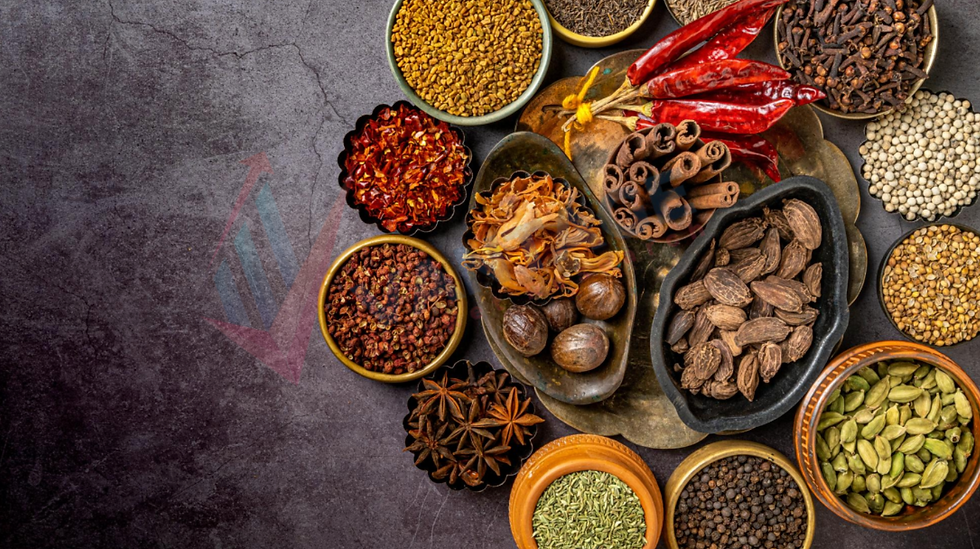Seasonings and Spices Market 2024: Growth Drivers, Challenges, and Future Trends
- Rahul Verma
- Oct 29, 2024
- 4 min read

The global seasoning and spices market has seen remarkable growth as consumers worldwide embrace diverse culinary tastes and healthier lifestyles. Seasonings and spices, essential for flavoring food, have expanded beyond traditional uses, entering health, wellness, and packaged food sectors. The increasing demand for exotic flavors and natural ingredients fuels market expansion, creating opportunities for both established companies and emerging players.
This blog explores the seasoning and spices market’s growth trends, key companies, segmentation by product and application, legal constraints, and future outlook.
Market Growth & Size
The global seasoning and spices market is on an upward trajectory, driven by rising culinary experimentation, health-conscious consumer choices, and the expanding food and beverage industry. In 2024, the market is valued at approximately USD 20.19 billion, with projections to reach USD 29.57 billion by 2032, growing at a compound annual growth rate (CAGR) of 4.89%.
Key growth drivers include:
Culinary Innovation: The rising popularity of global cuisines encourages the use of diverse seasonings and spices.
Health Benefits: Spices like turmeric and ginger, known for their health properties, drive demand as consumers prioritize wellness.
Processed Food Demand: Ready-to-eat and packaged foods require extensive seasoning, contributing to market growth.
Key Companies in the Seasoning and Spices Market
The seasoning and spices market includes prominent companies that continue to innovate with new flavors, sustainable sourcing, and health-oriented products. Leading players include:
McCormick & Company, Inc. – Known for its extensive range of spices and seasonings, McCormick leads in both retail and food service sectors.
Olam International – A global leader in the supply of raw spices, emphasizing sustainability and transparency.
Ajinomoto Co., Inc. – Offers seasonings with a focus on umami flavors, catering to Asian and Western markets.
Sensient Technologies Corporation – Known for its innovative flavor solutions in natural and specialty spices.
Kerry Group – Specializes in seasonings for processed and convenience foods, emphasizing health and wellness ingredients.
These companies focus on product diversification, quality, and sustainable sourcing to meet evolving consumer preferences.
Legal Constraints & Limitations
Regulatory Standards
The seasoning and spices market is subject to strict regulatory standards due to the health implications of food products and the global supply chain complexities. Key regulatory frameworks include:
Food Safety Standards: Seasonings and spices must comply with safety standards such as the FDA’s regulations in the U.S. and the EU’s food safety guidelines, particularly concerning contamination and labeling.
Organic Certifications: Demand for organic and non-GMO spices requires compliance with certification standards like USDA Organic and European Organic Standards.
Sustainable Sourcing Regulations: Many companies adopt fair-trade practices and sustainable sourcing to meet consumer expectations for ethically produced spices.
Market Limitations
Despite the growth potential, the seasoning and spices market faces several limitations:
Supply Chain Challenges: Spices often come from developing regions, where political instability, weather conditions, and logistical challenges can impact supply.
Price Volatility: Fluctuations in the cost of raw materials, driven by climate and demand variations, affect product pricing and margins.
Regulatory Compliance Costs: Meeting global food safety standards and certification requirements can be costly, particularly for small and medium enterprises.
Market Segmentation by Product and Application
By Product Type
The seasoning and spices market can be segmented into various types, each with unique applications and consumer preferences:
Herbs: Basil, rosemary, thyme, and other herbs are popular for flavoring and health benefits.
Spices: Includes cumin, pepper, turmeric, cinnamon, and more, used in a wide range of cuisines.
Blends and Mixes: Pre-mixed spices like curry powder and seasoning mixes for grilling, baking, and specific cuisines.
Salt and Salt Substitutes: Used in cooking and seasoning, including specialty salts like sea salt and Himalayan salt.
By Application
Seasonings and spices have diverse applications across sectors, segmented as follows:
Food and Beverage Industry: The largest segment, covering applications in cooking, baking, and processed foods.
Personal Care and Cosmetics: Spices such as turmeric and cinnamon are increasingly used in personal care products for their skin-enhancing properties.
Healthcare and Pharmaceuticals: Certain spices, like ginger and turmeric, are used in medicinal products due to their anti-inflammatory and antioxidant properties.
Household Use: Spices and seasonings in small packaging for everyday cooking in homes worldwide.
Future Forecast: Trends and Opportunities
The future of the seasoning and spices market is shaped by consumer preferences, sustainability, and health trends. Key emerging trends include:
Organic and Non-GMO Spices: Consumers increasingly prefer organic and non-GMO certified spices, driving demand for sustainably grown products.
Rising Popularity of Exotic Flavors: Globalization has increased demand for exotic spices like saffron, sumac, and za'atar, expanding flavor horizons.
Functional and Health-Oriented Spices: Spices known for health benefits, such as turmeric and ginger, are gaining popularity as consumers seek natural wellness solutions.
Sustainable Packaging: With a focus on reducing plastic waste, companies are adopting sustainable packaging options for their spice products.
E-commerce Growth: Online sales of spices and seasonings are on the rise, particularly for specialty and hard-to-find spices, as e-commerce expands globally.
Conclusion
The seasoning and spices market is a dynamic and growing sector, fueled by culinary diversity, health-conscious choices, and a global demand for flavors. With leading companies focusing on quality, sustainability, and innovation, the market is well-positioned to continue its upward trajectory. However, challenges such as regulatory compliance and supply chain limitations require strategic adaptation.
As consumer preferences evolve, the seasoning and spices market is likely to expand further, offering ample opportunities for growth and innovation in the years ahead.
Contact Us for more information on the seasoning and spices Market Research 2023–2030 Forecast : Or Phone Call us :
USA — +1 507 500 7209 | India — +91 750 648 0373
Browse More Articles
Seed Treatment Market Growth



Comments